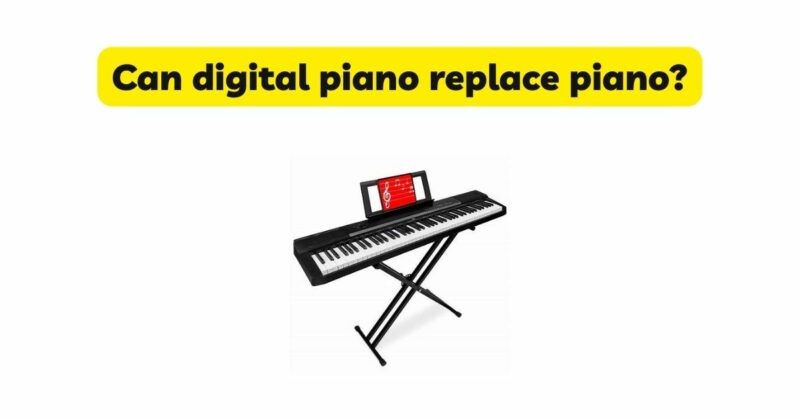The emergence of digital pianos has sparked a debate regarding their ability to replace traditional acoustic pianos. In this article, we will delve into the question of whether digital pianos can replace acoustic pianos. By examining their unique features, sound quality, touch sensitivity, versatility, practicality, and technological advancements, we aim to provide insights that shed light on the role of digital pianos in the ever-evolving world of music.
- Sound Quality and Reproduction: One of the primary considerations when comparing digital pianos to acoustic pianos is sound quality and reproduction. Acoustic pianos produce sound acoustically through the vibration of strings, resulting in a rich, resonant tone. Digital pianos, on the other hand, employ sampling technology or synthesis to replicate piano sounds electronically. While digital pianos have made significant strides in reproducing realistic piano tones, they may not fully capture the complexity and richness of an acoustic piano’s sound. However, high-end digital pianos come close to emulating the acoustic piano experience, offering convincing and enjoyable sound reproduction.
- Touch Sensitivity and Key Action: The touch sensitivity and key action of a piano play a crucial role in expressive playing and technique development. Acoustic pianos have touch-sensitive keys that respond to the player’s touch, allowing for nuanced dynamics and articulation. Digital pianos aim to replicate this touch sensitivity by incorporating weighted or graded hammer action keys. While digital pianos can provide a realistic playing experience, the feel of the keys and the touch sensitivity may not be identical to an acoustic piano. Nonetheless, advancements in digital piano technology have closed the gap, providing pianists with a satisfying touch response for expressive playing.
- Versatility and Sound Options: One advantage of digital pianos over acoustic pianos is their versatility and sound options. Digital pianos offer a wide range of instrument sounds beyond just piano tones. They can emulate various instruments, such as strings, organs, synthesizers, and more. This versatility allows musicians to explore different genres, experiment with various sounds, and even compose and arrange music using a single instrument. While acoustic pianos excel in producing the unique and authentic piano sound, digital pianos provide a broader palette of sounds, making them suitable for a range of musical styles and preferences.
- Practicality and Maintenance: Digital pianos offer practical advantages over acoustic pianos. They are generally more compact, lightweight, and portable, making them suitable for musicians who travel frequently or have limited space. Acoustic pianos, on the other hand, are larger, heavier, and often require professional assistance for transportation and installation. Moreover, digital pianos do not require tuning like acoustic pianos do, resulting in cost savings and minimal maintenance requirements. This practicality and low-maintenance nature make digital pianos an attractive option for many musicians.
- Technological Advancements and Integration: Digital pianos benefit from continuous technological advancements, offering features that enhance the playing experience. Many digital pianos have built-in connectivity, allowing for seamless integration with computers, recording equipment, and educational software. They can also connect to external devices such as smartphones and tablets, enabling access to a wealth of educational resources and digital sheet music. Additionally, digital pianos often incorporate practice tools, interactive lessons, and performance features that facilitate learning, creativity, and musical exploration.
- Musical Context and Performance Considerations: When considering whether digital pianos can replace acoustic pianos, it is essential to consider the musical context and performance requirements. Acoustic pianos, particularly grand pianos, are often the preferred choice for concert halls, formal performances, and classical music settings. Their unique sound projection, tonal complexity, and resonance make them ideal for professional pianists seeking a traditional and immersive performance experience. Digital pianos, on the other hand, excel in versatility, portability, and integration capabilities, making them suitable for various musical contexts, including live performances, home practice, studios, and contemporary music genres.
Conclusion: The question of whether digital pianos can replace acoustic pianos is complex and multifaceted. While digital pianos have made tremendous progress in replicating the sound and feel of an acoustic piano, they cannot completely replicate the rich tonal complexity and touch sensitivity of their acoustic counterparts. However, digital pianos offer unique advantages such as versatility, portability, practicality, and technological integration that cater to the changing needs and preferences of musicians in the digital age.
Ultimately, the choice between a digital piano and an acoustic piano depends on personal preferences, musical goals, performance requirements, and practical considerations. Some musicians may prefer the timeless charm and authenticity of an acoustic piano, while others may appreciate the convenience and versatility offered by digital pianos. It is important to consider factors such as sound quality, touch sensitivity, versatility, practicality, and budget when making a decision.
Rather than viewing digital pianos as a replacement for acoustic pianos, it is more productive to see them as complementary instruments that can coexist in the musical landscape. Both instruments have their own strengths and applications, and each can contribute to a musician’s artistic growth and expression. Embrace the technological advancements and possibilities that digital pianos offer, while also recognizing and appreciating the timeless beauty and artistry of acoustic pianos.


